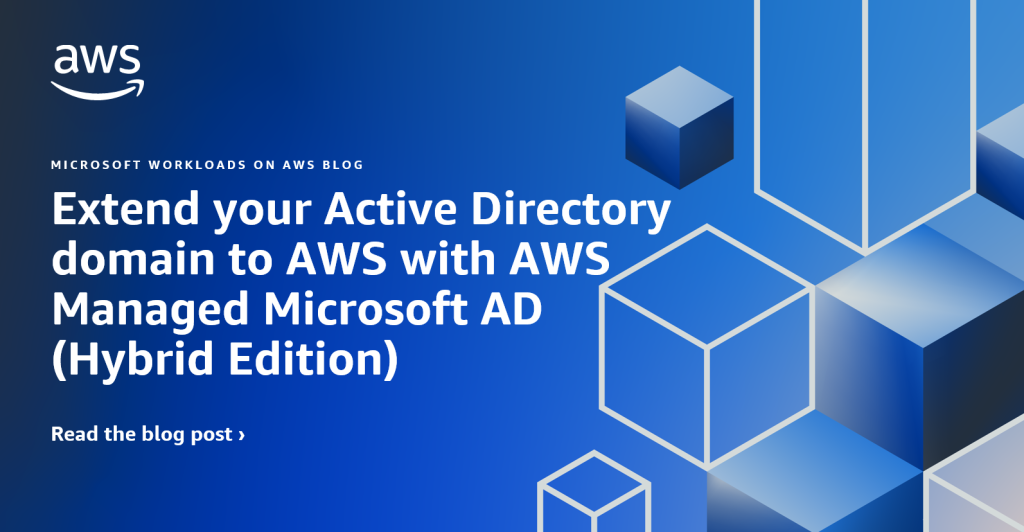Microsoft Workloads on AWS
Category: Best Practices
Mastering SQL Server Backups with T-SQL Snapshots and Amazon FSx for NetApp ONTAP
In this blog post, we will guide you through the process on performing a snapshot backup using native T-SQL based backup abilities and snapshot technology of Amazon FSx for NetApp ONTAP (FSxN). This method provide near-instant, consistent backups with negligible I/O, storage and compute capacity impact unlike traditional Microsoft SQL Server backups. Introduction Microsoft SQL […]
Optimize CPUs best practices for SQL Server workloads – continued
In this blog post, we will extend the analysis of the Optimize CPUs feature provided in a previous publication to other Amazon Elastic Compute Cloud (Amazon EC2) instances suitable for deployment of Microsoft SQL Server workloads on the Amazon Web Services (AWS) Cloud. Amazon EC2 now allows customers to modify an instance’s CPU options to […]
Extend your Active Directory domain to AWS with AWS Managed Microsoft AD (Hybrid Edition)
Introduction Today, we are announcing the general availability of the Hybrid Edition of AWS Directory Service for Microsoft Active Directory (AWS Managed Microsoft AD). This new edition lets you extend your existing self-managed Active Directory (AD) domain to AWS Managed Microsoft AD while preserving your current identity and access infrastructure. AWS Managed Microsoft AD (Hybrid […]
Testing 3-tier Windows app resilience on AWS with Resilience Testing
Resilience testing has emerged as a critical practice for organizations seeking to build and maintain resilient cloud applications. As environments grow more complex, more comprehensive testing methods become necessary. Resilience testing principles can be applied to Windows workloads on AWS to create controlled experiments that test system behavior under stress. These experiments can help you […]
Automating SQL Server Point-in-Time Recovery Using EBS Snapshots
This blog post introduces a new AWS feature that enables point-in-time recovery for SQL Server using EBS snapshots. It offers a detailed walkthrough for creating VSS-integrated snapshots and restoring SQL Server databases using EBS snapshots to simplify database backups and automate point-in-time restore. Introduction Amazon Web Services (AWS) recently introduced support for restoring Microsoft SQL […]
How to use ACM PCA Connector for AD to enable LDAPS for your Active Directory
September 15, 2025: AWS Private CA Connector for Active Directory now supports server-side LDAPS certificate enrollment for AWS Managed Microsoft AD domain controllers. To learn how to enable server-side LDAPS for your AWS Managed Microsoft AD directory using AWS Private CA Connector for Active Directory, please refer to our updated documentation. In this blog, we […]
Compliant and Cost-Effective Microsoft Dynamics 365 CE Implementation on AWS
Learn how HCLTech successfully helped a customer implement Microsoft Dynamics 365 Customer Engagement (D365 CE) on AWS cloud. To gain a deeper understanding into HCLTech’s consultative approach and the insights from this project, we spoke with Karthik Rajan and Anand K Patel, Solutions Architects at HCLTech. We explore key considerations including purchase models, licensing optimization, […]
Mastering Windows Server migration to Amazon EC2: Key tactics for success – Part 1
Introduction We will explore key considerations that frequently arise during the Microsoft Windows Server migration process and offer practical insights and solutions to complete a successful transition. Migrating Windows Server to Amazon Elastic Compute Cloud (Amazon EC2) requires careful planning and decision-making to align with business and technical requirements. Amazon Web Services (AWS) provides the […]
Ola Hallengren’s SQL Server Maintenance Solution in AWS
In this blog, we will demonstrate using Ola Hallengren’s SQL Server Maintenance Solution with native backups to Amazon S3. A common task for customers is to configure database backups and maintenance jobs for their SQL Servers. Ola Hallengren’s SQL Server Maintenance Solution scripts can simplify this task by automating SQL Server database backup and maintenance […]
MultiCloud cost visibility with Amazon QuickSight and FOCUS
Customers with multi-cloud environments struggle to effectively track and manage their usage and costs. They access the individual billing portals of each cloud provider to gather cost information. Without a consolidated view on cloud expenditure, making data-driven decisions to optimize costs becomes difficult. In September 2023 we introduced the Cloud Intelligence Dashboard for Azure. This […]









